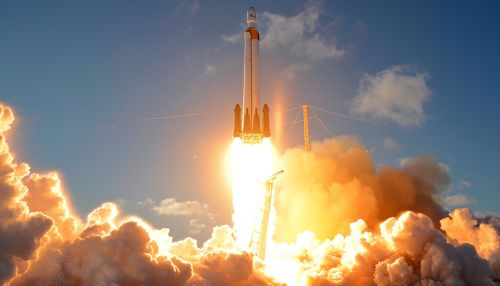Launch Vehicle
Introduction
A launch vehicle or carrier rocket is a vehicle designed to propel payloads into space. Launch vehicles are used to carry satellites, scientific instruments, or spacecraft into various types of orbit (e.g., geostationary, polar, etc.) or beyond Earth's gravitational pull altogether. The payload can include anything from communications satellites to interplanetary probes, and even manned spacecraft.


History
The concept of using rockets for the purpose of sending payloads to space dates back to the early 20th century. The first successful launch vehicle was the V-2 developed by Germany during World War II. The V-2 was the first man-made object to reach the edge of space. After the war, both the United States and the Soviet Union captured V-2 rockets and technology, and used these as the basis for their own rocket development programs.
The first successful orbital launch was conducted by the Soviet Union in 1957 with the launch of Sputnik 1, using the R-7 launch vehicle. This marked the beginning of the space age. Since then, a wide variety of launch vehicles have been developed and used by countries and private companies around the world.
Design and Construction
The design and construction of a launch vehicle is a complex process that requires a deep understanding of various scientific and engineering principles. The main components of a launch vehicle include the propulsion system, the payload system, the guidance system, and the structural system.
The propulsion system, often a rocket engine, provides the thrust necessary to overcome Earth's gravity and propel the vehicle into space. The payload system is designed to carry and protect the payload during launch and in space. The guidance system is responsible for controlling the vehicle's flight path, while the structural system provides the necessary support and stability for the vehicle.
Propulsion Systems
The propulsion system of a launch vehicle is one of its most critical components. It is responsible for providing the thrust necessary to propel the vehicle into space. There are several types of propulsion systems used in launch vehicles, including liquid propellant engines, solid propellant engines, and hybrid engines.
Liquid propellant engines use a liquid fuel and an oxidizer, which are combined and ignited to produce thrust. Solid propellant engines use a single propellant that is in a solid state. Hybrid engines use a combination of liquid and solid propellants.
Payload Systems
The payload system of a launch vehicle is designed to carry and protect the payload during launch and in space. The payload can include satellites, scientific instruments, or spacecraft. The payload system must be designed to withstand the harsh conditions of space, including extreme temperatures and radiation.
The payload is typically housed in a protective shell known as the payload fairing. The fairing protects the payload from the aerodynamic forces and heat experienced during launch. Once the vehicle has reached space, the fairing is jettisoned to reduce weight.
Guidance Systems
The guidance system of a launch vehicle is responsible for controlling the vehicle's flight path. It ensures that the vehicle follows the correct trajectory to reach its intended orbit. The guidance system uses a combination of sensors, computers, and control systems to monitor and adjust the vehicle's flight path.
The guidance system typically includes an inertial navigation system, which uses accelerometers and gyroscopes to measure the vehicle's velocity and orientation. It may also include a GPS system for additional accuracy.
Structural Systems
The structural system of a launch vehicle provides the necessary support and stability for the vehicle. It includes the vehicle's frame, which must be strong enough to withstand the forces experienced during launch, as well as the vibration and acoustic energy generated by the propulsion system.
The structural system also includes the vehicle's tanks, which hold the propellant for the propulsion system. These tanks must be designed to withstand the pressure of the propellant and the forces experienced during launch.
Launch Sites
Launch vehicles are typically launched from specially designed facilities known as spaceports. These facilities provide the necessary infrastructure for launching vehicles into space, including launch pads, vehicle assembly buildings, and tracking stations.
The location of a spaceport is often chosen based on its proximity to the equator, as this allows for the most efficient use of Earth's rotational speed to assist in the launch. Some of the most well-known spaceports include the Kennedy Space Center in the United States, the Baikonur Cosmodrome in Kazakhstan, and the Guiana Space Centre in French Guiana.
Future Developments
The field of launch vehicles is constantly evolving, with new technologies and designs being developed to improve efficiency, reduce costs, and increase payload capacity. One of the most significant recent developments is the move towards reusable launch vehicles.
Companies like SpaceX and Blue Origin have developed launch vehicles that can return to Earth after delivering their payload to space, landing vertically on a landing pad. This has the potential to significantly reduce the cost of launching payloads to space, as the same vehicle can be used multiple times.
